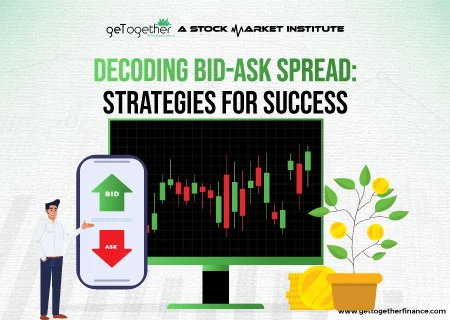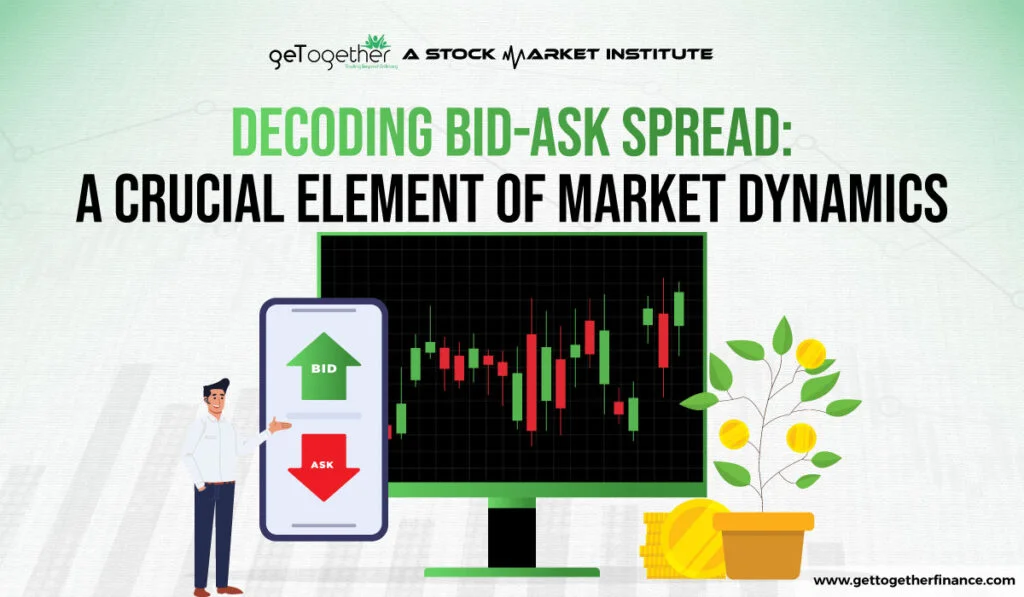Decoding Bid-Ask Spread: A Crucial Element of Market Dynamics


Table of Contents
ToggleIntroduction
In the financial market, the concept of bid-ask spread is a fundamental aspect of trading. For instance, if a seller quotes a stock’s ask price at $100 and a buyer places a bid at $95, the difference between these two prices—$5—is known as the bid-ask spread. This spread represents the transaction cost and reflects the asset’s market liquidity.
Traders and investors frequently analyze the bid-ask spread to gauge the market’s depth and the potential cost of entering or exiting positions.
Knowing the bid and ask rates and the difference is crucial for investors to make the right decisions. In this blog, we aim to discuss all the crucial aspects of the bid and offer spread you need to know as a trader.
What Is a Bid-Ask Spread?

In simple terms, the bid-ask spread reflects the difference between an asset’s highest bid price and the lowest ask price. There is no rocket science in calculating it, as it is a simple numerical difference. But first, let’s understand what each component of the word means:
- Bid Price: The highest price a buyer is willing to pay for an asset.
- Ask or Offer Price: The lowest price a seller is willing to accept for an asset.
- Bid-Ask Spread / Spread: The numerical difference between the bid and the ask rates.
*Note: A seller always wants to sell at a higher price than a buyer wants to pay. Hence, the bid-ask spread is always positive.
Let’s try and understand it with a couple of examples:
Example 1: Here are the market quotes of Stock A.
| Bid Price | Bid Quantity | Ask Price | Ask Quantity |
| 95 | 1,000 | 105 | 50,000 |
| 94 | 1,115 | 104 | 25,232 |
| 93 | 1,245 | 103 | 21,100 |
| 92 | 1,569 | 102 | 20,600 |
| 91 | 3,594 | 101 | 5,500 |
| 90 | 20,645 | 100 | 912 |
Going by the definition,
Bid-Ask Spread=Lowest Ask Price-Highest Bid Price
Bid-Ask Spread for Stock A=Rs. 100-Rs. 95=Rs. 5
Example 2: Suppose you see the quote for USD vs INR as Rs. 83.02 / 83.48
Here, the Bid rate is Rs. 83.02, and the Ask rate is Rs. 83.48. So, the bid-ask spread is:
Bid-Ask Spread for USD vs INR=Rs. 83.48-Rs. 83.02=Rs. 0.46
Bid-ask spread is influenced by many factors, including:
- Market Liquidity
- Trade Volume
- Volatility
A narrow spread indicates high volumes and high liquidity, whereas a wider spread represents lesser volumes and less liquidity.
Bid-Ask Spread and Liquidity

Liquidity shows how easily an asset can be bought or sold in the market without impacting the price volatility. The bid-ask spread is a direct indicator of the liquidity of an asset:
- Narrow Spread: When there are many buyers and sellers and the transactions occur quickly at stable prices, it creates high liquidity leading to a narrow spread.
- Wide Spread: When there are fewer buyers and sellers, and the transactions cause high price volatility, it creates low liquidity, leading to a wider spread.
Large trades have a lower impact on the market price when there is high liquidity, leading to lower transaction costs. The converse is true in a low liquidity scenario.
Also Read: Momentum Trading
Elements of the Ask and Bid Spread

Many elements affect the bid-ask spread. Each plays a vital role in determining whether an asset is narrow or widespread. These elements are as follows:
- Market Makers: Institutional investors, stock brokers, and HNIs usually place multiple orders quoting both bid and ask prices. They increase the liquidity in the market and earn by profiting from the spreads. As they almost control the market movements, they are called market makers.
- Order Size: Orders placed for large quantities are executed in parts. This is because of difficulties in finding matching buy or sell orders. As a result, the bid-ask spread increases.
- Market Conditions: If the markets are volatile, the spreads are wider as the market experiences uncertainty. On the other hand, more stable markets have a lower spread.
- Asset Type: The type of asset controls the liquidity and affects the spread. For example, stocks listed in the Nifty 50 index experience less volatility and are highly liquid, leading to a lower spread. Meanwhile, a small-cap stock would experience much higher volatility.
How Does Bid and Offer Spread Work?

To understand the mechanics of the stock markets, it is essential to understand how the ask and bid spread works. If you know it, you can benefit by riding the right side of the tide. Here’s a simplified explanation:
- Quoting Prices: Buyers and sellers quote prices at which they are willing to trade an asset. These market participants create the bid and ask spread.
- Order Matching: The trade is executed when a buyer’s bid matches a seller’s offer. Unless a match is found, the order remains open.
- Market Makers: They bring liquidity to the markets by continuously placing bid-ask orders. The bid-ask spread is their profit.
- Spread Dynamics: The fluctuations in the spread are based on demand and supply. With high demand, the spread is lower, and with low demand, it is higher.
Considering the Bid-Ask Spread

Consider the bid-ask spread to design your strategy as a trader. Here’s how your investments and returns are affected by the spread:
- Transaction Costs: A wider spread means higher transaction costs leading to lesser profits.
- Order Timing: You can time your orders to reduce costs. When there is high liquidity, you can minimize costs. Using limit orders to set acceptable prices can reduce the impact when the spread is wider.
- Asset Selection: Investing in highly traded assets can grant the benefit of liquidity.
Bid-Ask Spread Formula
Calculating the bid-ask spread is pretty straightforward. Here is the formula to calculate the spread:
Bid-Ask Spread=Lowest Ask Price-Highest Bid Price
You can also calculate the percentage of the spread by using this formula:
Percentage Spread=Ask Price – Bid PriceAsk Price100
In Example 1, taken earlier, the calculation of the percentage spread is as follows:
Percentage Spread=100 – 95100100=5%
Conclusion
The bid-ask spread is one crucial element reflecting market dynamics. Understanding the spread, its components, and its implications can significantly enhance trading strategies and decision-making. By learning about the bid-ask spread, you can manage your transaction costs and safeguard your capital by investing only in highly liquid stocks. Visit our website to access the benchmark courses for traders. Explore our tailor-made courses designed by experts to make you ace traders.
Faqs
How do we profit from bid-ask spread?
To profit from the bid-ask spread, you can place simultaneous buying and selling orders by quoting the bid and ask prices. You gain the spread on each squared trade as your trade gets executed. It is better to choose and invest in high-liquidity assets to safeguard your capital from volatility.
What is a good bid-ask spread?
Classifying a bid and offer spread as good or bad is wrong. As far as intraday traders are concerned, a lower spread is favorable to them. It promotes stability and liquidity in the markets. Moreover, the quoted prices are also truer. However, a higher spread is good for traders with a longer outlook.
Why is the bid-ask spread a transaction cost?
Suppose you want to buy a stock. The price you quote is the bid price, whereas what the seller wants to sell it at is called the ask rate. Now, consider that both of you are negotiating the price to reach a consensus. The price at which the transaction occurs is somewhere between the bid and ask rates. If the spread is higher, you have to pay more, and the seller gets less.
Now, consider that you are selling and buying the stock simultaneously, which is the case with the bid-ask spread. The spread is a cost, and it’s better when it’s lower.



 Facebook
Facebook Instagram
Instagram Youtube
Youtube
